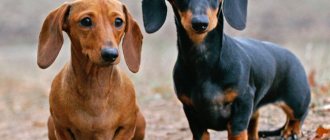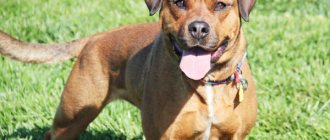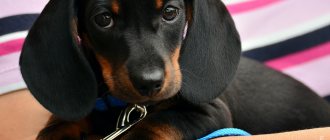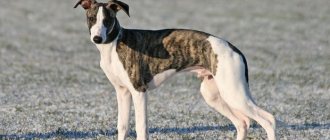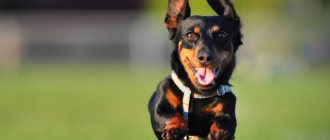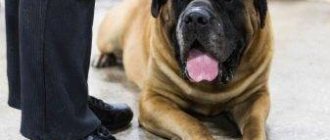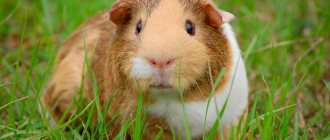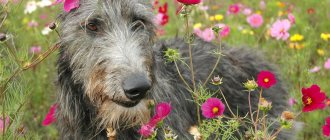Origin story
The place of origin of dachshunds is considered to be Germany. After the standard breed was developed, work was carried out to improve the dogs' hunting skills. Breeders sought to develop a breed of miniature size, so that it would not only be practical for humans, but also have an attractive appearance.
Hare hunting was common in many European countries in the 18th and 19th centuries. Rabbit holes have narrow passages, so the dog had to be able to not only crawl into them, but also move around calmly there. Therefore, breeders from all over Germany set about breeding the optimal dwarf breed.
Among all the varieties obtained, the rabbit (rabbit) dachshund has become the most common among breed connoisseurs. By the end of the 19th century, well-established work on breeding rabbit dachshunds was organized. The work was not easy, since crossing dwarf breeds always produces miniature body sizes. In order for a rabbit dachshund to fully meet the standard, a lot of time and effort had to be spent. The result justified the efforts; representatives of the breed are popular to this day.
Description of the breed
The rabbit dachshund is a miniature dog with short legs, an elongated body, and long ears. The main difference between this variety and standard dwarf dachshunds is the size of an adult dog. The rabbit has a chest girth of up to 30 cm, the standard one – more than 35.
There are three types of rabbit dachshund:
- long-haired;
- wire-haired;
- smooth-haired
Description of appearance is the same for everyone:
- weight of an adult dog – 3-4 kg;
- height – 12-16 cm;
- the head is elongated, the muzzle is narrowed towards the nose;
- large black nose;
- scissor bite;
- ears dropped down, rounded;
- long, straight back;
- toned torso;
- wide chest;
- powerful, muscular legs;
- tail of medium length, pointed.
Stately posture is a feature of the breed. The body looks toned, muscular, there are no folds. If your dachshund is obese, this immediately affects its appearance, and you need to urgently visit a veterinarian.
Colors and coat
The characteristics of the coat depend on its type:
- Smooth-haired. The most common type, in particular demand among lovers of decorative dogs. The coat fits tightly to the body, has a dense structure, and is short in length. Such dogs look attractive, their hairs are similar to velvety fabric that glistens in the sun.
- Long-haired. Rarely used for hunting. Long hairs require special care; they look luxurious and rich. The long-haired rabbit dachshund is an excellent option for a small decorative dog.
- Wirehaired. In our area they are not in great demand; their appearance is less attractive. Connoisseurs of this variety note its funny appearance; the long beard looks outstanding. The coat is thick, bristly-like, thanks to it dogs can survive in harsh conditions - excellent for hunting.
The acceptable color of the rabbit dachshund varies. They can be one-color, two-color, mixed. The first two types are most common; the solid color usually has a red tint. Two-tone coloring is also common, when the main color is black or brown, it is complemented by tan marks of other shades.
Mixed color implies the presence of many colors: black, brown, gray, red; the spots should not be large. Such representatives of the breed are rare.
Appearance
All Dachshunds, regardless of size, must meet the breed standard, that is, maintain working characteristics. Quadrupeds should not be too heavy or light, their body structure is harmonious. The muscles are developed, but flat. The joints are large and strong. The characteristics of the breed describe the rabbit Dachshund as a brave, intelligent, attentive companion and hunter. The size of an adult dog (at 15 months) is estimated by:
- Height: up to 30 cm.
- Weight: 2.5–3 kg.
- Chest circumference: 30 cm.
The difference between a rabbit dachshund and a dwarf dachshund is only 5 cm in height (and chest circumference). A dog 31 cm tall will already be considered dwarf. Naturally, the parameters are a guideline, not a law. If according to the pedigree the puppy is recorded as a “rabbit” and he has outgrown the permissible height limit, then he will no longer receive a new pedigree. More significantly, the rabbit Dachshund differs from the usual one. The weight of the standard variety can reach 10 kg.
Breed standard
- The head is of proportional size, in the shape of an elongated wedge, set proudly and high. The forehead is almost flat, the back of the head is pronounced, the brow ridges are moderately expressed. The length of the head is divided into two equal parts - the muzzle and the forehead. The transition is smooth, only marked. The muzzle narrows, but does not become sharp, the lips are tightly fitting, of medium thickness with full pigmentation.
- The teeth are healthy, in full set and in a correct locking bite. The canines close tightly, the incisors stand on parallel lines and close together without gaps.
- The nose is sensitive, colored to match the coat, preferably black.
- The eyes are expressive, oval with an attentive gaze. The eyelids are close-fitting, black or colored to match the nose.
- The ears are triangular with rounded tips. Set the ears at eye level or slightly lower. When at rest, the ears droop to the sides of the head and the tips touch the cheekbones.
- The body is elongated, strong, muscular, but compact. The neck is quite long, curved, giving the stance insolence and pride. The withers are powerful, the back is flat or sloping to the croup. The loin is strong and long, the croup is sloping but not steep. The groins are moderately tucked, without a sharp “undermining” line.
- Limbs – confidently placed, without markings, almost even. On the front paws, the wrists are allowed to move closer together, which can cause the paws to appear narrowed. The front paws are placed under the body, the hind paws are set wider. The hock joints are very strong and large. The brushes are oval, slightly elongated with powerful claws.
- The tail is of standard length, not too thin, carried freely or at the level of the spine. It is desirable for the tail to be straight, but a crescent shape is equivalent.
Character
Representatives of the breed are companions for the owner and his family. Dachshunds are perfect for living in a large family with children, for one person, or for the elderly. If there is a child in the house, the pet will become for him, on the one hand, a toy, a partner in fun, amusement, and on the other, a protector, nanny, and security guard. However, Dachshunds will not tolerate bad treatment. If children and adults treat them inappropriately, the animals will not tolerate it. They will definitely fight back either with their behavior or even with aggression.
Distinctive character traits are activity, energy, and curiosity. If you plan to keep your dog alone within four walls all day, it is better to choose a different breed. Bonded to people, cheerful dachshunds will not survive in such conditions. They experience a long separation from their owner especially acutely.
The hunting skills of the representatives of the breed, which are in their blood, periodically make themselves felt even to dogs that have lived their entire lives as decorative pets. If a rodent or other small animal runs nearby, the dachshund will immediately react and be ready to chase it.
The hunting instincts of the rabbit dachshund prevent it from living peacefully in the same house with other animals, especially rodents. Small puppies can play with them, and over time they will begin to see them as their target.
The mini rabbit breed is small in size and weight. Despite this, the pet is always ready to defend its owner and his property when danger arises. The guarding instinct appears in puppies immediately after birth. High intelligence does not allow them to behave inappropriately. They will never attack first or show causeless aggression.
Character and features
The small size of a dog does not mean that it is weak and sees life only from the sofa. Due to their small size and bred for active hunting, the breed is more intelligent, agile and inventive, and the endless flow of energy and restless character of this dog is not always controllable.
The dog's character is ambitious, the dog is always cheerful and playful. A distinctive character trait is that the dachshund is fearless, with it you will never be afraid of dark places, despite its size, this breed will never leave its owner in danger.
It's hard for her to be alone - it seems so boring that she can't survive being separated from her owner for a long time.
Therefore, when leaving for work, leave your rabbit dachshund as many toys as possible, let them be within reach, if this is not done, she will find toys for herself - it is better to remove shoes, wires, adapters, small equipment from the floor in advance, everything that the dog can chew and ruin it.
The rabbit dachshund is a curious dog, it will always have time to find something that is not lying well, and due to its nature, it will certainly chew and destroy it.
But this may not protect you completely either, it is impossible to hide wallpaper or live without flowers, and your neighbors will tell you more than once that the dog howls in your absence - but don’t be alarmed, the dog will be calmer with age. To prevent such cases, walk your dog more often, play and let him run around to his heart's content.
Care and maintenance
Like any other breed, dachshunds require special rules for care and maintenance. The animal's fur needs regular brushing. Haircuts are rarely done; usually a trimming procedure, offered in many salons, is sufficient. Wire-haired representatives of the breed especially need it.
Bathing is extremely rare. Until the age of six months, it is recommended to avoid contact with water; after that, water procedures are performed as necessary. The skin of a rabbit dachshund is very delicate, so it is important to buy shampoos for gentle washing, using massaging, gentle movements when lathering. The water should be at room temperature; too warm will cause discomfort.
Trimming claws is a prerequisite for keeping an animal. It can be done at home by purchasing special nippers. The first procedure for trimming claws is best done in a salon, watching the master work.
Caring for your pet also includes daily examination of the ears and teeth. If inflammatory processes occur, you should immediately contact a veterinarian. If your pet regularly has health problems affecting these organs, the doctor may prescribe the use of antiseptic and other agents on an ongoing basis.
Feeding
The main rule when choosing a diet for a pet is that the food should be healthy and nutritious. The easiest way is to buy ready-made food of high quality, containing useful components in sufficient quantity for the dog. It’s easy to calculate the quantity; you must follow the manufacturer’s recommendations.
If you decide to cook for your pet yourself, the rule about choosing nutritious food is also relevant. Only fresh or properly stored products should be used. You should decide on the choice of food before the puppy arrives in the house, so that he immediately gets used to it.
Dachshunds are not picky when it comes to food. Unlike many breeds, they enjoy eating raw and stewed vegetables.
The list of permitted products is extensive:
- several types of lean meat;
- fish (a couple of times a week);
- cereals, pasta;
- boiled eggs;
- dairy products;
- vegetables fruits;
- bread (occasionally).
The following are strictly prohibited for use:
- pork;
- confectionery;
- fried, fatty, spicy foods;
- too salty food;
- smoked meats, sausages;
- boiled bones.
The pet should be switched to two meals a day by the age of 8 months. The optimal feeding time is after a walk, then the dachshund should lie down; active activities immediately after eating are contraindicated. It is advisable to feed your pet at the same time every day. The dog should always have access to clean water.
Training and education
After the puppy arrives in the house, it is important to teach him:
- Respond to name. This usually takes no more than a few days. Popular nicknames for boys are Archie, Freddie, Charlie, for girls - Baby, Tina, Lana. You need to make your choice before the puppy arrives in the house, so that you can immediately handle it correctly.
- Know your place. To make it easier for the puppy to remember its place, it should be as comfortable as possible. It is necessary to use new, clean bedding and create all conditions for the pet to spend time normally. It is advisable to immediately present the dog with a toy, luring it to its place.
After that, start learning basic commands. The easiest way to do this is when the vaccinations are done, you can take your pet for walks. It is important to maintain consistency; you cannot call the command in different words, for example, if the prohibiting command is “fu”, ordering “no” is pointless, the animal will only get confused. Dachshunds are easy to train, so after basic commands you can train using any of the available programs. It is best to contact dog handlers.
Upbringing
Due to their confidence and endless energy, rabbit dachshund puppies require training and education. It is necessary to raise a puppy in strictness, but do not go too far. You can educate yourself, or you can trust professionals, but this must be done in a timely manner, even in puppyhood.
The dachshund is very capricious, if you don’t start training right away, then in the future you will end up with an uncontrollable spinning top, and this is not so pleasant for both you and your pet.
- The most severe punishment is when no attention is paid to her, but you shouldn’t forget about rewards, dachshunds are quite emotional and can have a hard time worrying.
Often they refuse to follow commands and do not see the owner at all, do not get upset in such cases, just be patient, the dog will still give in to you after some time.
Despite all their royal breed, dogs of this breed easily get along with their neighbors; if there is a dog or cat in the house, the rabbit dachshund will easily make friends with them.
Diseases and life expectancy
The average life expectancy of representatives of the breed is 12-15 years. In many ways, this period depends on the conditions of detention, timely implementation of vaccinations, and proper attention during old age. Several times a year, a pet of any age should be shown to a veterinarian.
The lifespan of rabbit dachshunds also depends on gender (girls live longer), lack of stress, and compliance with hygiene rules.
Genetic features of the body structure and internal organs of dachshunds cause the following diseases:
- obesity;
- ear diseases;
- joint inflammation;
- spinal dysplasia.
Small stature and a long body look attractive, but can become a provoking factor for the development of these other diseases. It is strictly forbidden for dachshunds to jump from heights, even small ones, as they are susceptible to injury. For any bruise or dislocation, you must contact a veterinarian.
Basic rules of care
If you have purchased a wire-haired rabbit dachshund, never neglect caring for it. After all, the pet’s health, as well as the quality and duration of its life, depend on it.
Main stages of care :
- wiping the muzzle with food, since the wire-haired rabbit has a thick beard, on which food particles always remain;
- coat care. This includes: cutting mustaches and beards, trimming, cutting hair between the fingers;
- bathing with special shampoos. But remember - shampoos should not be used often, once every 3-4 months, so as not to cause irritation and damage the hair. You need to bathe your dog often without using any products, as it gets dirty all the time;
- combing is carried out at least once every six months;
- Nail trimming is carried out once every 2 weeks using a special tool;
- Your pet's ears require special attention. Examine them regularly and, at the slightest suspicion, contact a veterinarian;
- The pet's eyes should be clean and clear, and they should not be watery or have any purulent discharge. For prevention, you can wash your eyes with a decoction of chamomile or tea;
- Your pet's teeth should be brushed 1-2 times a week, using special brushes and pastes for dogs. In order for your pet to tolerate this procedure well, teach him to brush his teeth from childhood.
Pros and cons of the breed
The following are the advantages and disadvantages of the breed:
| + | — |
| Attractive appearance | Need for long daily walks |
| Hunting, guarding, defensive skills | It is important to strictly monitor your weight |
| Inconsistency in food | Wool needs protection when walking |
| They love children and maintain good relationships with all family members. | Doesn't get along well with other pets |
| Easy to learn, quickly remember basic commands, can master special programs | They do not tolerate bad treatment; if a child offends them, they can become aggressive |
| With proper care they have a long life expectancy |
Where to buy and price
The average price for representatives of the breed with documents is 15,000-25,000 rubles. It depends on the color and type of coat. It is not difficult to find a nursery offering representatives of the breed; CERTUS, Emerald Fairy Tale, Kinchville, and others are popular. Buying a puppy without documents from an unverified place is risky.
The rabbit dachshund is a small dog with a bright, eye-catching appearance. Today it is more used as an ornamental breed rather than a hunting breed, but courage and agility are innate qualities. A dachshund will not be able to live alone, if you devote time and effort to it, it will become a true four-legged friend for the whole family. She will be especially comfortable among a large family with children.
